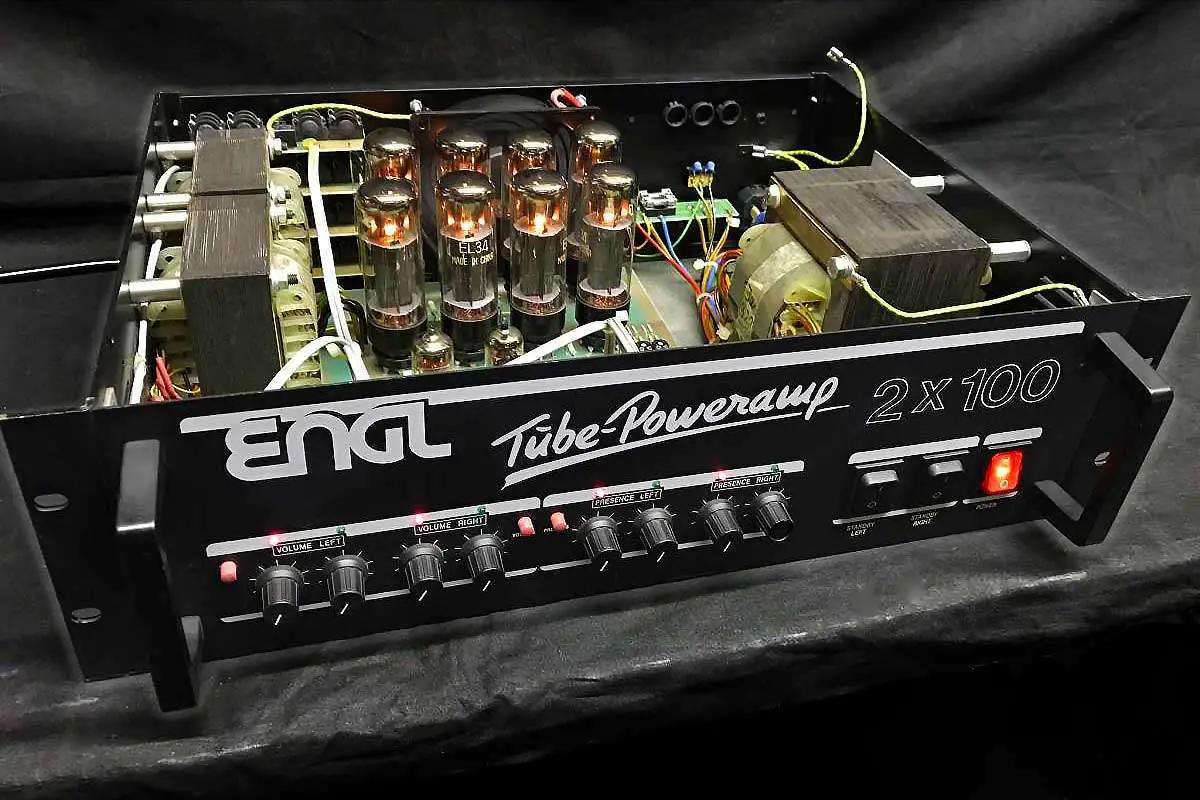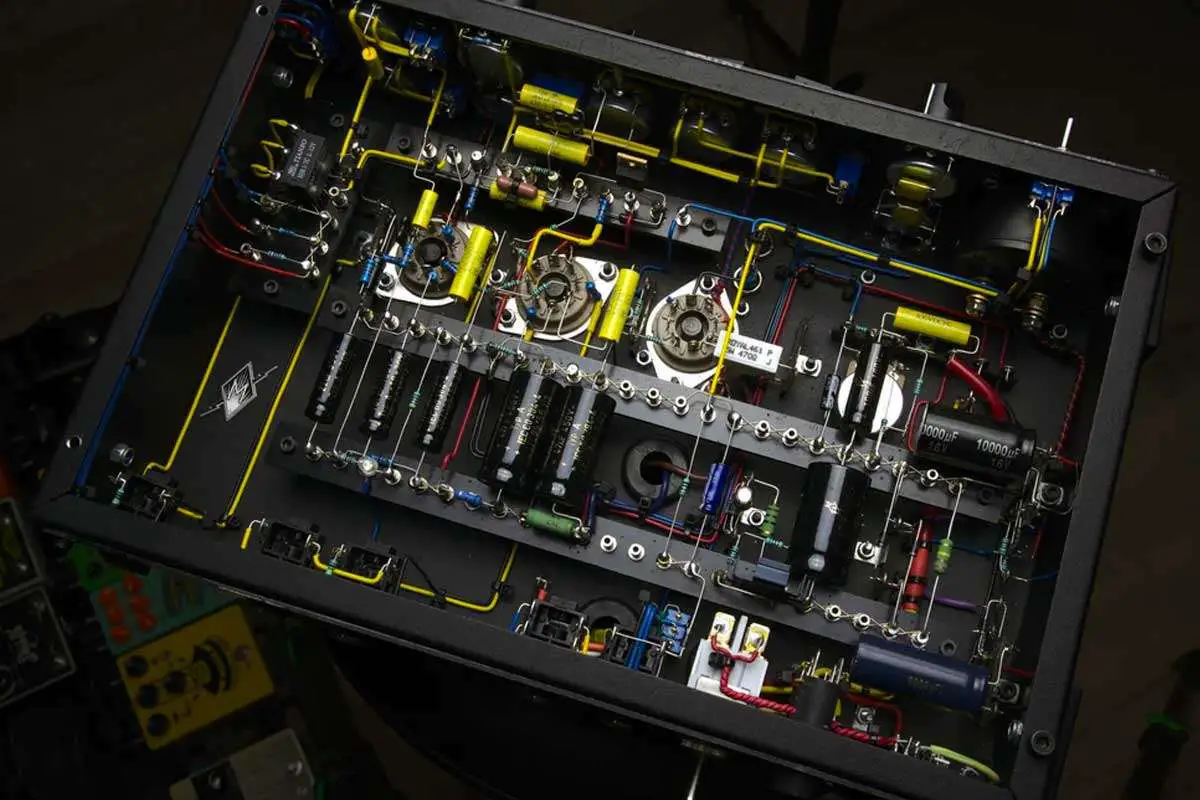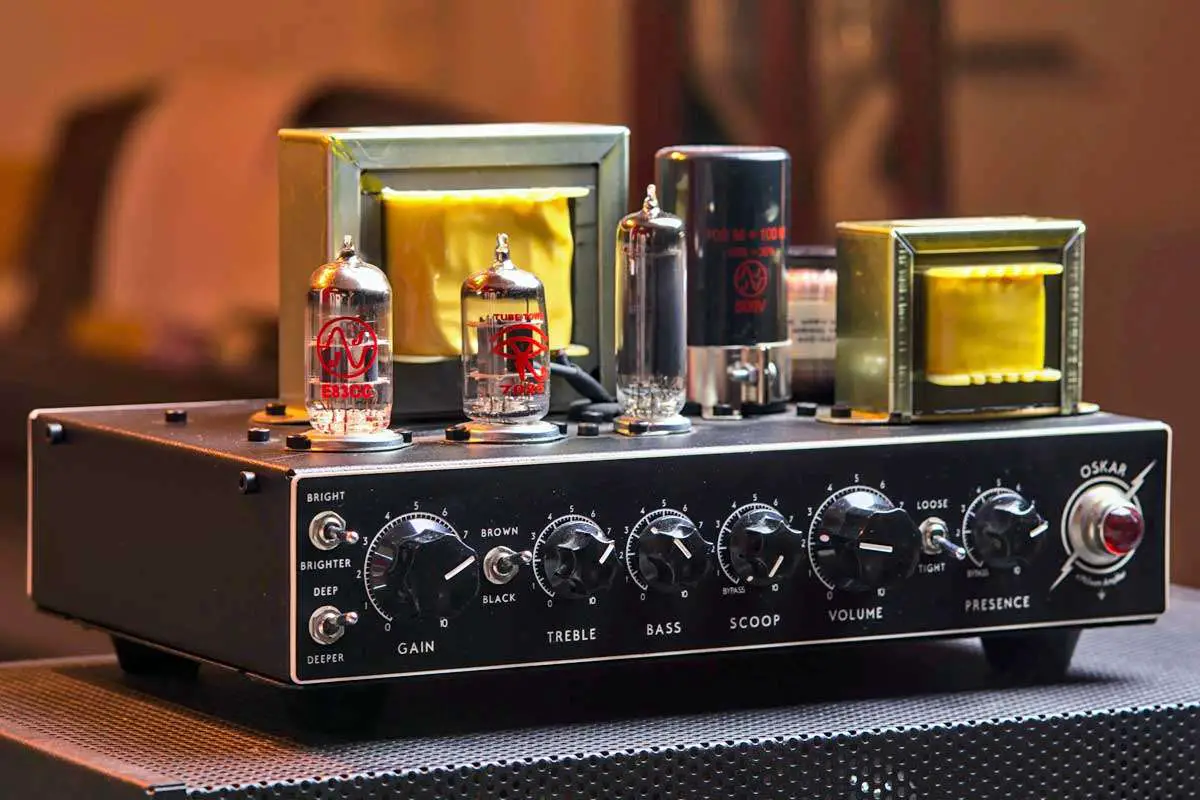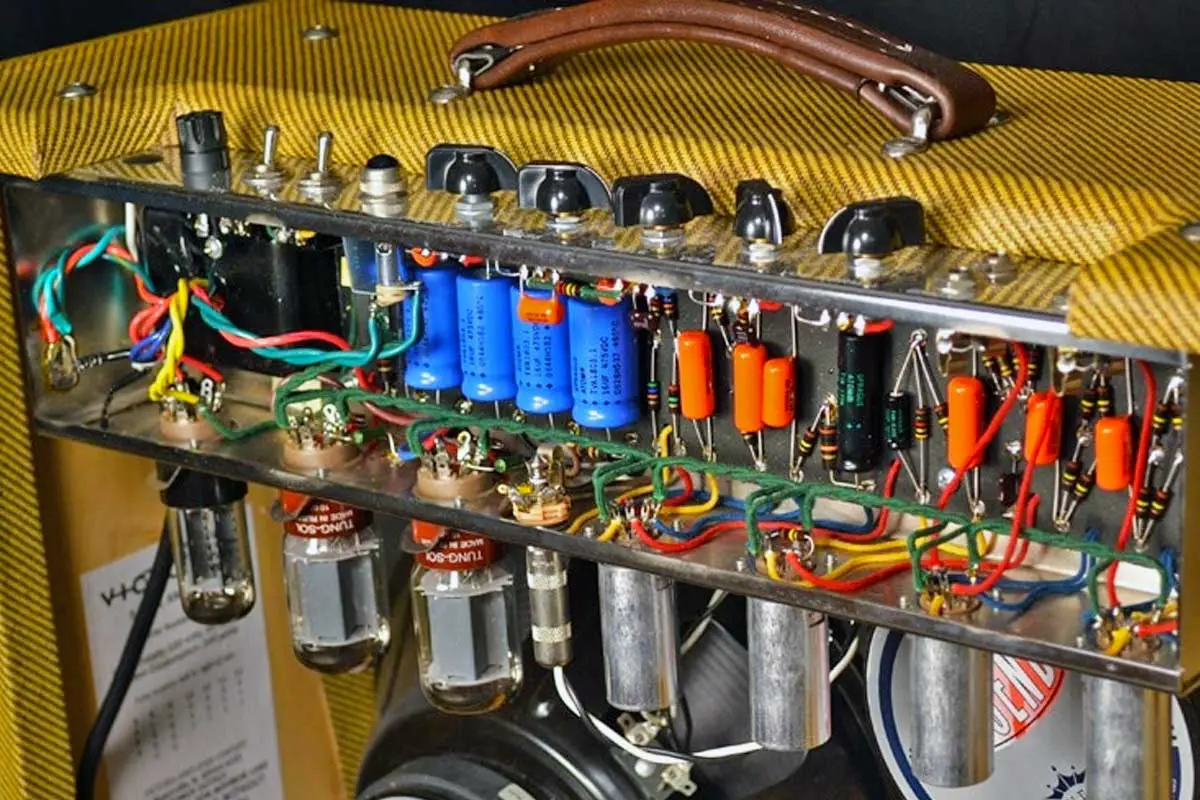In the realm of audio equipment, understanding the functions and differences between a power amp vs preamp types is essential for optimizing your sound system. A power amplifier, as the name suggests, amplifies the signal power to drive your speakers at the required volume without distortion. It’s the muscle of your audio setup, taking the low-level signal from the source or a preamplifier and boosting it to a level that can move the speakers’ cones back and forth to create sound.
On the other hand, a preamplifier serves a different purpose. It takes the initial audio signal from your input device, such as a turntable or CD player, or guitar and conditions it. This process involves not only some initial amplification but also equalization and volume control, ensuring that the signal is clean and tailored to your preferences before it reaches the power amp.
It’s the synergy between these two types of amplifiers that shapes the listening experience that tube amps are known for. While a power amplifier ensures your speakers can produce a large enough sound, the preamplifier fine-tunes this sound to your liking, making sure that what you hear is not only loud enough but also sonically pleasing. Thus, both the power amp and preamp play crucial roles in delivering high-quality audio.

Understanding Amplifiers
When choosing an amplifier, you’re faced with numerous options, each affecting sound quality and operational use in your audio system. Making an informed decision requires understanding the differences and applications of various amplifiers.
Definition and Role of Amplifiers
Amplifiers, at their core, enhance audio signals to drive speakers effectively, ensuring your music or audio is heard with clarity and sufficient volume. The main function of an amplifier is to increase the power of a signal, thereby allowing your audio equipment to produce sound at the desired volume with high fidelity.
Types of Amplifiers
Power Amplifiers and Preamplifiers are the primary amplifier types you’ll encounter:
- Power Amplifiers: These are responsible for delivering the required power to drive your loudspeakers. They take the low-level audio signal from the preamp and significantly boost its power before sending it to the speakers, which demands careful consideration for matching with your speaker’s power handling capacities.
- Preamplifiers: Serving as the control center, preamps manage source signals, apply necessary processing, and then pass the moderated line-level output to the power amp. A preamp’s quality is crucial, as it sets the stage for the sound that your power amp will further amplify.
By comprehending the distinct roles of power amps and preamps, your decision in assembling an audio system that meets your needs becomes significantly more straightforward.
Principles of Preamps
Before diving into the nitty-gritty of preamps, understand that they are essential for managing the low-level signals from your inputs and preparing them for further amplification or processing. They give you control over volume and tone shaping through EQ controls and contribute significantly to the clarity and fidelity of your audio setup.
Preamp Functionality
Your preamp’s primary role is to take the low-level signal from an input device, such as a microphone or instrument, and boost it to a line level. This gain adjustment is crucial because it allows the signal to be processed by EQ, effects, and other circuits without introducing excessive noise or distortion. Use the low-cut filter to eliminate unwanted low-frequency noises and the EQ controls to shape the tonal quality before the signal reaches the power amplifier.
Preamp Components
In a preamp, you will find various components that contribute to its functionality. The input stage, often equipped with XLR or RCA connectors, is where your signal enters. Volume and gain controls allow you to adjust the amplitude of the signal. The power supply is vital for maintaining a constant and noise-free voltage to the circuit. A preamp pedal, which is a portable version, can offer similar features for live performances or as an addition to recording setups.
Connecting Preamps to Other Equipment
Connecting your preamp correctly to other devices ensures optimal performance. Use XLR cables for balanced microphones to minimize interference, while RCA cables are common for hi-fi equipment. Remember, the preamp’s output should be sent to a power amp or recording interface at adequate line level to keep the integrity of the signal. Always match the levels and impedances to avoid preamp distortion or signal degradation.
Power Amp Basics
In this section, you will understand the core functions and principles behind power amplifiers, which are essential for delivering the necessary wattage for driving your speakers with clarity and strength, while managing distortion.

Purpose of Power Amps
Power amps amplify the line level signal they receive from preamps or mixers to a higher voltage level, which is necessary to drive the movement of speakers’ cones and produce sound. They define the final character of your audio, affecting loudness and overall sonic quality. Another crucial task is matching the output impedance of the power amp to the speakers, ensuring maximum power transfer without damaging the components.
Operating Principles
The primary role of a power amplifier is to boost a low-power audio signal to a higher level of power, adequate for driving loudspeakers. This is usually measured in wattage. A key aspect you need to watch for is clipping, which occurs when an amp is driven beyond its capacity, creating distortion. Power amps often come with gain control to manage this and avoid damage to your speakers or the amp itself.
Moreover, power amplifiers must manage bass and other frequencies efficiently to prevent distortion and maintain the fidelity of the audio. The loudness of the output is directly related to the amount of power provided by the amplifier, and understanding the impedance of your speaker cab as well as the outputs of your amp is crucial to ensure compatibility and optimum performance.
Comparing Preamps and Power Amps
Before diving into specific details, familiarize yourself with the core differences between preamps and power amps: preamps boost a weak signal to line level, while power amps strengthen the signal enough to drive the speakers.
Distinct Functions
Both preamps (preamplifiers) and power amps have critical roles in your audio systems, but their functions are materially distinct. Your preamp serves as the first point of amplification in your audio signal chain. It takes the low-level output from your sound source, like a turntable or microphone, and brings it up to a standard line level. Conversely, the power amp takes this line-level signal and amplifies it further to a level powerful enough to move the loudspeakers within your home theater or AV receiver.
- Preamp: Amplifies weak signals to line level.
- Power Amp: Amplifies line-level signals to speaker-driving levels.
Signal Flow
The signal flow through your audio system is sequential and critical for proper function. A signal originates from your sound source and first reaches the preamp. The role of the preamp here is pivotal, as it conditions the signal—often improving its quality—and prepares it for further amplification. Following the preamp, the power amp takes over, increasing the signal strength to a degree that can power up your speakers efficiently, giving you the audible output you hear.
Sound Source → Preamp → Power Amp → Speakers
Interdependence
Preamps and power amps, though separate units, work in tandem within most complex audio systems. Neither is independent; the preamp relies on the power amp to achieve ultimate sound projection, while the power amp depends on the preamp to receive a well-adjusted signal for final amplification. For instance, in a home theater setup, an AV receiver integrates both a preamp and a power amp to manage and amplify signals, highlighting their interdependence for delivering high-quality audio.
- Preamp: Depends on the power amp for sound projection.
- Power Amp: Requires the preamp for adjustable signal input.
Connectivity and Compatibility
In the realm of audio equipment, connectivity and compatibility are crucial for achieving the desired sound quality and functionality. Your understanding of these aspects aids in the seamless integration of power amps and preamps with existing audio setups.
Inputs and Outputs
Power Amp: Your power amp typically possesses either balanced XLR or unbalanced 1/4-inch TS/TRS inputs, and heavy-duty outputs to connect to passive speakers using speaker cables.
Preamp: On the other hand, preamps often come with a variety of inputs to accept signals from different sources, such as microphones, instruments, and line-level devices. It’s common to find XLR and 1/4-inch inputs, as well as outputs to send the processed signal to a power amp or active speakers.
For connection to an audio interface or mixer, the preamp outputs and power amp inputs must be compatible, often requiring high-quality cables to preserve signal integrity.
Typical Connectors:
- XLR (balanced)
- 1/4-inch TS or TRS (can be balanced or unbalanced)
- RCA (unbalanced)
Matching Components with Amps
When integrating a guitar amp or AV receiver into your system, ensure that the impedance and level of the preamp’s output match those of the power amp’s input, to prevent damaging your equipment and to maintain sound fidelity.
Guitar Amps: A specific concern for guitarists is matching the preamp output with the guitar amp input to avoid tonal loss or additional noise.
Related: Types of Guitar Amps
Active speakers and headphones sometimes eliminate the need for a separate power amp, as they can be driven directly from the preamp outputs. Nevertheless, check the compatibility with respect to the signal level and connector type.
Remember when connecting:
- Impedance matching is vital for preventing damage and ensuring efficiency.
- Cable quality affects signal transmission and should be chosen carefully.
By focusing on these connectivity essentials, you ensure your audio system operates at its best, avoiding common pitfalls related to mismatched or improperly connected equipment.
Advanced Amplifier Features
Sophistication in power amplification and preamplification can vastly enhance your audio experience. These are not just about loudness but about shaping your tone to perfection and enriching it with various sound effects.

Tone Shaping Controls
Your amplifier’s tone is significantly influenced by bass and treble controls. The presence of advanced EQ knobs allows you to sculpt the low, mid, and high frequencies, tailoring your sound to your preference. The low-cut filter is a crucial feature, managing unwanted bass frequencies that can muddle your clarity, and gain control adjusts the amount of distortion in your signal, letting you go from a clean signal to a crunch with ease.
Related: Guitar Amp Settings Guide
Expanding with Effects Loops
An effects loop helps you incorporate external effects after the preamp stage but before the power amp. This lets your core signal maintain its integrity, using the preamp’s tone shaping and compression without the added effects, which can be blended in afterwards for a cleaner and more precise sound quality.
Related: An In-depth Guide on Effects Loops
Amplifier Modulation and Accessories
You can enhance your amplifier’s functionality with various modules and accessories. Voltage can be a major player in tone quality; higher voltage rails provide more headroom for a more dynamic sound. Channels give you options—often a clean and an overdrive channel—with each offering independent controls for gain, volume, and EQ. Lastly, accessories like footswitches allow for hands-free control over features such as reverb and presence, offering you real-time command over your sonic landscape.
Troubleshooting and Maintenance
Maintaining optimal functionality and addressing common issues is crucial when it comes to both power amplifiers and preamplifiers. Proper care ensures your equipment consistently delivers clean signals and operates without complications.
Common Amplifier Issues
Clipping: One frequent problem is clipping, which occurs when an amplifier is pushed beyond its limits, potentially damaging speakers. If you hear harsh, distorted sounds, especially at higher volumes, this could be an indicator of clipping. To resolve this, you should reduce the volume or check if your power supply is adequate.
Power Supply Problems: A faulty or undersized power supply can cause various issues, including low output, noise, and thermal shutdown. Regularly examine your power supply for any signs of wear or failure.
Long-Term Care and Upkeep
- Routine Maintenance: To ensure longevity, perform regular maintenance checks. This includes verifying all connections are secure and using a can of compressed air to clean any dust from vents and components.
- Clean Signals: Keep signal paths short and use quality cables to prevent noise and maintain clean signals to your headphones or other output devices.
- Temperature Control: Amplifiers operate best in well-ventilated areas away from direct sunlight to prevent overheating.
Remember, a little upkeep goes a long way in extending the life and performance of your audio amplifiers.
Conclusion

Understanding the Role of Preamps and Power Amps
The choice between a power amplifier and preamplifier depends on your specific needs and the existing components of your audio system. It’s important to recognize that each device plays a distinct role:
- Preamplifiers amplify low-level signals to line-level, which is the standard operating level for audio processing devices.
- Power amplifiers boost the line-level audio signals to a level strong enough to drive your speakers.
When researching to make an informed decision, consider that a preamplifier is essential for detailed control over your audio source selection and sound levels. On the other hand, if your setup requires driving speakers directly, a power amplifier is necessary to provide the needed muscle.
| Purpose | Device |
|---|---|
| Signal control | Preamplifier |
| Speaker driving | Power Amplifier |
